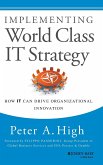The Digital Revolution in Health
Herausgegeben:Beranger, Jerome; Rizoulieres, Roland
The Digital Revolution in Health
Herausgegeben:Beranger, Jerome; Rizoulieres, Roland
- Gebundenes Buch
- Merkliste
- Auf die Merkliste
- Bewerten Bewerten
- Teilen
- Produkt teilen
- Produkterinnerung
- Produkterinnerung
What sort of health system do we want to implement in the face of the imminent arrival of artificial intelligence and robotics in medical practices? The Covid-19 health crisis has demonstrated the importance of digital technologies in the care of patients and their families, as imperative attention was called to ethics and relational practice.
This book analyzes numerous sources of feedback to reveal the multiple facets of this so-called Medicine 4.0. It reveals the extent to which digital medicine requires new forms of organization and new approaches to co-conception, in a logic that is…mehr
Andere Kunden interessierten sich auch für
![Altering Frontiers Altering Frontiers]() Altering Frontiers187,99 €
Altering Frontiers187,99 €![The Contributory Revolution The Contributory Revolution]() Pierre GiorginiThe Contributory Revolution187,99 €
Pierre GiorginiThe Contributory Revolution187,99 €![Liberalism and Capitalism Today Liberalism and Capitalism Today]() Paul-Jacques LehmannLiberalism and Capitalism Today186,99 €
Paul-Jacques LehmannLiberalism and Capitalism Today186,99 €![Immersive Technologies to Accelerate Innovation Immersive Technologies to Accelerate Innovation]() Sylvain FleuryImmersive Technologies to Accelerate Innovation187,99 €
Sylvain FleuryImmersive Technologies to Accelerate Innovation187,99 €![Innovation Economics, Engineering and Management Handbook 2 Innovation Economics, Engineering and Management Handbook 2]() Innovation Economics, Engineering and Management Handbook 2187,99 €
Innovation Economics, Engineering and Management Handbook 2187,99 €![Innovation Economics, Engineering and Management Handbook 1 Innovation Economics, Engineering and Management Handbook 1]() Innovation Economics, Engineering and Management Handbook 1186,99 €
Innovation Economics, Engineering and Management Handbook 1186,99 €![Implementing World Class It Strategy Implementing World Class It Strategy]() Peter A. HighImplementing World Class It Strategy50,99 €
Peter A. HighImplementing World Class It Strategy50,99 €-
-
-
What sort of health system do we want to implement in the face of the imminent arrival of artificial intelligence and robotics in medical practices? The Covid-19 health crisis has demonstrated the importance of digital technologies in the care of patients and their families, as imperative attention was called to ethics and relational practice.
This book analyzes numerous sources of feedback to reveal the multiple facets of this so-called Medicine 4.0. It reveals the extent to which digital medicine requires new forms of organization and new approaches to co-conception, in a logic that is resolutely collaborative with patients. The book concludes with legal and ethical points of view in order to challenge the reader on their duty to truly be an "actor" of their health care.
Hinweis: Dieser Artikel kann nur an eine deutsche Lieferadresse ausgeliefert werden.
This book analyzes numerous sources of feedback to reveal the multiple facets of this so-called Medicine 4.0. It reveals the extent to which digital medicine requires new forms of organization and new approaches to co-conception, in a logic that is resolutely collaborative with patients. The book concludes with legal and ethical points of view in order to challenge the reader on their duty to truly be an "actor" of their health care.
Hinweis: Dieser Artikel kann nur an eine deutsche Lieferadresse ausgeliefert werden.
Produktdetails
- Produktdetails
- Verlag: Wiley & Sons / Wiley-ISTE
- Artikelnr. des Verlages: 1W786306950
- 1. Auflage
- Seitenzahl: 256
- Erscheinungstermin: 17. August 2021
- Englisch
- Abmessung: 240mm x 161mm x 18mm
- Gewicht: 508g
- ISBN-13: 9781786306951
- ISBN-10: 1786306956
- Artikelnr.: 62029006
- Herstellerkennzeichnung
- Libri GmbH
- Europaallee 1
- 36244 Bad Hersfeld
- gpsr@libri.de
- Verlag: Wiley & Sons / Wiley-ISTE
- Artikelnr. des Verlages: 1W786306950
- 1. Auflage
- Seitenzahl: 256
- Erscheinungstermin: 17. August 2021
- Englisch
- Abmessung: 240mm x 161mm x 18mm
- Gewicht: 508g
- ISBN-13: 9781786306951
- ISBN-10: 1786306956
- Artikelnr.: 62029006
- Herstellerkennzeichnung
- Libri GmbH
- Europaallee 1
- 36244 Bad Hersfeld
- gpsr@libri.de
Jerome Beranger is a scientific expert on the ethical approach of the digital revolution and Ethics by Evolution. He is a co-founder of ADELIAA and is also an associate researcher in the Inserm BIOETHICS team at the University of Toulouse III, France. Roland Rizoulières is a health economist, a lecturer at Sciences Po Aix, France, and a researcher at INSERM. He is also a senior commissioner at the Army Health Service (Army Epidemiology and Public Health Center).
Foreword xi
Dominique PON, Stéphane OUSTRIC, Jérôme BÉRANGER
Acknowledgements xv
Introduction xvii
Jérôme BÉRANGER and Roland RIZOULIÈRES
Part 1. The Health System and Digital Technology: Challenges, Issues, and Transformations 1
Introduction to Part 1 3
Roland RIZOULIÈRES
Chapter 1. Digital Integration and Healthcare Pathways in the Territories 5
Roland RIZOULIÈRES
1.1. Introduction 5
1.2. What lessons can be learned from integrated American and Swiss models? 8
1.2.1. The cradle: the United States 8
1.2.2. The Swiss model of the Delta network 13
1.3. Digital technology as a challenge for territorial integration in the context of healthcare in France 16
1.3.1. Healthcare territories: starting from the patient-user rather than from the offer of health and medico-social actors? 17
1.3.2. An exemplary structuring of the territory? The TSN program and the E-Parcours 20
1.3.3. What lessons can be learned? 23
1.3.4. PTAs and CPTS: the Alpha and Omega of healthcare territory structuring? 23
1.3.5. Launch of SNAC in regions 25
1.4. Digital integration and aging in France: from health pathway to life pathway 26
1.5. Conclusion 27
1.6. References 28
Chapter 2. Digital Technology in a Cancer Patient's Primary-Secondary Care Journey 35
Marie-Ève ROUGÉ-BUGAT
2.1. Introduction 35
2.2. Organization of cancer care 36
2.2.1. Cancer plans 36
2.2.2. Primary care actors 36
2.3. Regional health organization for patient management 38
2.3.1. Healthcare supply 38
2.3.2. Transmission of information 40
2.4. Theoretical pathway of a cancer patient 41
2.5. Cancer announcement 44
2.6. Management of treatment-related adverse events 45
2.7. Patient follow-up 47
2.7.1. After cancer 47
2.7.2. Alternating monitoring 48
2.8. Ethics to support the primary to secondary care journey 49
2.8.1. Deontology 50
2.8.2. Ethical questioning 51
2.8.3. Impacts and consequences of digital technology on the healthcare pathway 52
2.9. Conclusion 53
2.10. References 54
Chapter 3. A Smart Health Record for Better Coordination: A Sociological Analysis of the Organizational Dynamics of the Calipso Project 57
Valentin BERTHOU
3.1. Solving health problems through better coordination 57
3.1.1. A context conducive to home automation technologies in healthcare 57
3.1.2. A digital liaison notebook to facilitate the transmission of information 59
3.2. Historicity of the Calipso project 62
3.2.1. A bundle of information for thinking about the digital liaison notebook 62
3.2.2. Territorial anchoring of the project in an already established network of actors 63
3.3. Collaboration as an object of study and theoretical framework 64
3.3.1. A multidisciplinary team to carry out a project "in Living Lab mode" 64
3.3.2. What theoretical framework for dealing with complex situations? Knotworking, the core of reflection on the activity 66
3.4. Identifying specific coordination problems to propose a general technological solution 68
3.4.1. Building on problems identified in the field 68
3.4.2. A design for experimentation, functionalities for the needs of professionals 69
3.4.3. Through the projection of professional standards in the tool, misunderstanding of coordination and collaboration 70
3.4.4. Technology, neutral ground for cooperation? 72
3.5. Methodological course of the tailor-made ex
Dominique PON, Stéphane OUSTRIC, Jérôme BÉRANGER
Acknowledgements xv
Introduction xvii
Jérôme BÉRANGER and Roland RIZOULIÈRES
Part 1. The Health System and Digital Technology: Challenges, Issues, and Transformations 1
Introduction to Part 1 3
Roland RIZOULIÈRES
Chapter 1. Digital Integration and Healthcare Pathways in the Territories 5
Roland RIZOULIÈRES
1.1. Introduction 5
1.2. What lessons can be learned from integrated American and Swiss models? 8
1.2.1. The cradle: the United States 8
1.2.2. The Swiss model of the Delta network 13
1.3. Digital technology as a challenge for territorial integration in the context of healthcare in France 16
1.3.1. Healthcare territories: starting from the patient-user rather than from the offer of health and medico-social actors? 17
1.3.2. An exemplary structuring of the territory? The TSN program and the E-Parcours 20
1.3.3. What lessons can be learned? 23
1.3.4. PTAs and CPTS: the Alpha and Omega of healthcare territory structuring? 23
1.3.5. Launch of SNAC in regions 25
1.4. Digital integration and aging in France: from health pathway to life pathway 26
1.5. Conclusion 27
1.6. References 28
Chapter 2. Digital Technology in a Cancer Patient's Primary-Secondary Care Journey 35
Marie-Ève ROUGÉ-BUGAT
2.1. Introduction 35
2.2. Organization of cancer care 36
2.2.1. Cancer plans 36
2.2.2. Primary care actors 36
2.3. Regional health organization for patient management 38
2.3.1. Healthcare supply 38
2.3.2. Transmission of information 40
2.4. Theoretical pathway of a cancer patient 41
2.5. Cancer announcement 44
2.6. Management of treatment-related adverse events 45
2.7. Patient follow-up 47
2.7.1. After cancer 47
2.7.2. Alternating monitoring 48
2.8. Ethics to support the primary to secondary care journey 49
2.8.1. Deontology 50
2.8.2. Ethical questioning 51
2.8.3. Impacts and consequences of digital technology on the healthcare pathway 52
2.9. Conclusion 53
2.10. References 54
Chapter 3. A Smart Health Record for Better Coordination: A Sociological Analysis of the Organizational Dynamics of the Calipso Project 57
Valentin BERTHOU
3.1. Solving health problems through better coordination 57
3.1.1. A context conducive to home automation technologies in healthcare 57
3.1.2. A digital liaison notebook to facilitate the transmission of information 59
3.2. Historicity of the Calipso project 62
3.2.1. A bundle of information for thinking about the digital liaison notebook 62
3.2.2. Territorial anchoring of the project in an already established network of actors 63
3.3. Collaboration as an object of study and theoretical framework 64
3.3.1. A multidisciplinary team to carry out a project "in Living Lab mode" 64
3.3.2. What theoretical framework for dealing with complex situations? Knotworking, the core of reflection on the activity 66
3.4. Identifying specific coordination problems to propose a general technological solution 68
3.4.1. Building on problems identified in the field 68
3.4.2. A design for experimentation, functionalities for the needs of professionals 69
3.4.3. Through the projection of professional standards in the tool, misunderstanding of coordination and collaboration 70
3.4.4. Technology, neutral ground for cooperation? 72
3.5. Methodological course of the tailor-made ex
Foreword xi
Dominique PON, Stéphane OUSTRIC, Jérôme BÉRANGER
Acknowledgements xv
Introduction xvii
Jérôme BÉRANGER and Roland RIZOULIÈRES
Part 1. The Health System and Digital Technology: Challenges, Issues, and Transformations 1
Introduction to Part 1 3
Roland RIZOULIÈRES
Chapter 1. Digital Integration and Healthcare Pathways in the Territories 5
Roland RIZOULIÈRES
1.1. Introduction 5
1.2. What lessons can be learned from integrated American and Swiss models? 8
1.2.1. The cradle: the United States 8
1.2.2. The Swiss model of the Delta network 13
1.3. Digital technology as a challenge for territorial integration in the context of healthcare in France 16
1.3.1. Healthcare territories: starting from the patient-user rather than from the offer of health and medico-social actors? 17
1.3.2. An exemplary structuring of the territory? The TSN program and the E-Parcours 20
1.3.3. What lessons can be learned? 23
1.3.4. PTAs and CPTS: the Alpha and Omega of healthcare territory structuring? 23
1.3.5. Launch of SNAC in regions 25
1.4. Digital integration and aging in France: from health pathway to life pathway 26
1.5. Conclusion 27
1.6. References 28
Chapter 2. Digital Technology in a Cancer Patient's Primary-Secondary Care Journey 35
Marie-Ève ROUGÉ-BUGAT
2.1. Introduction 35
2.2. Organization of cancer care 36
2.2.1. Cancer plans 36
2.2.2. Primary care actors 36
2.3. Regional health organization for patient management 38
2.3.1. Healthcare supply 38
2.3.2. Transmission of information 40
2.4. Theoretical pathway of a cancer patient 41
2.5. Cancer announcement 44
2.6. Management of treatment-related adverse events 45
2.7. Patient follow-up 47
2.7.1. After cancer 47
2.7.2. Alternating monitoring 48
2.8. Ethics to support the primary to secondary care journey 49
2.8.1. Deontology 50
2.8.2. Ethical questioning 51
2.8.3. Impacts and consequences of digital technology on the healthcare pathway 52
2.9. Conclusion 53
2.10. References 54
Chapter 3. A Smart Health Record for Better Coordination: A Sociological Analysis of the Organizational Dynamics of the Calipso Project 57
Valentin BERTHOU
3.1. Solving health problems through better coordination 57
3.1.1. A context conducive to home automation technologies in healthcare 57
3.1.2. A digital liaison notebook to facilitate the transmission of information 59
3.2. Historicity of the Calipso project 62
3.2.1. A bundle of information for thinking about the digital liaison notebook 62
3.2.2. Territorial anchoring of the project in an already established network of actors 63
3.3. Collaboration as an object of study and theoretical framework 64
3.3.1. A multidisciplinary team to carry out a project "in Living Lab mode" 64
3.3.2. What theoretical framework for dealing with complex situations? Knotworking, the core of reflection on the activity 66
3.4. Identifying specific coordination problems to propose a general technological solution 68
3.4.1. Building on problems identified in the field 68
3.4.2. A design for experimentation, functionalities for the needs of professionals 69
3.4.3. Through the projection of professional standards in the tool, misunderstanding of coordination and collaboration 70
3.4.4. Technology, neutral ground for cooperation? 72
3.5. Methodological course of the tailor-made ex
Dominique PON, Stéphane OUSTRIC, Jérôme BÉRANGER
Acknowledgements xv
Introduction xvii
Jérôme BÉRANGER and Roland RIZOULIÈRES
Part 1. The Health System and Digital Technology: Challenges, Issues, and Transformations 1
Introduction to Part 1 3
Roland RIZOULIÈRES
Chapter 1. Digital Integration and Healthcare Pathways in the Territories 5
Roland RIZOULIÈRES
1.1. Introduction 5
1.2. What lessons can be learned from integrated American and Swiss models? 8
1.2.1. The cradle: the United States 8
1.2.2. The Swiss model of the Delta network 13
1.3. Digital technology as a challenge for territorial integration in the context of healthcare in France 16
1.3.1. Healthcare territories: starting from the patient-user rather than from the offer of health and medico-social actors? 17
1.3.2. An exemplary structuring of the territory? The TSN program and the E-Parcours 20
1.3.3. What lessons can be learned? 23
1.3.4. PTAs and CPTS: the Alpha and Omega of healthcare territory structuring? 23
1.3.5. Launch of SNAC in regions 25
1.4. Digital integration and aging in France: from health pathway to life pathway 26
1.5. Conclusion 27
1.6. References 28
Chapter 2. Digital Technology in a Cancer Patient's Primary-Secondary Care Journey 35
Marie-Ève ROUGÉ-BUGAT
2.1. Introduction 35
2.2. Organization of cancer care 36
2.2.1. Cancer plans 36
2.2.2. Primary care actors 36
2.3. Regional health organization for patient management 38
2.3.1. Healthcare supply 38
2.3.2. Transmission of information 40
2.4. Theoretical pathway of a cancer patient 41
2.5. Cancer announcement 44
2.6. Management of treatment-related adverse events 45
2.7. Patient follow-up 47
2.7.1. After cancer 47
2.7.2. Alternating monitoring 48
2.8. Ethics to support the primary to secondary care journey 49
2.8.1. Deontology 50
2.8.2. Ethical questioning 51
2.8.3. Impacts and consequences of digital technology on the healthcare pathway 52
2.9. Conclusion 53
2.10. References 54
Chapter 3. A Smart Health Record for Better Coordination: A Sociological Analysis of the Organizational Dynamics of the Calipso Project 57
Valentin BERTHOU
3.1. Solving health problems through better coordination 57
3.1.1. A context conducive to home automation technologies in healthcare 57
3.1.2. A digital liaison notebook to facilitate the transmission of information 59
3.2. Historicity of the Calipso project 62
3.2.1. A bundle of information for thinking about the digital liaison notebook 62
3.2.2. Territorial anchoring of the project in an already established network of actors 63
3.3. Collaboration as an object of study and theoretical framework 64
3.3.1. A multidisciplinary team to carry out a project "in Living Lab mode" 64
3.3.2. What theoretical framework for dealing with complex situations? Knotworking, the core of reflection on the activity 66
3.4. Identifying specific coordination problems to propose a general technological solution 68
3.4.1. Building on problems identified in the field 68
3.4.2. A design for experimentation, functionalities for the needs of professionals 69
3.4.3. Through the projection of professional standards in the tool, misunderstanding of coordination and collaboration 70
3.4.4. Technology, neutral ground for cooperation? 72
3.5. Methodological course of the tailor-made ex








